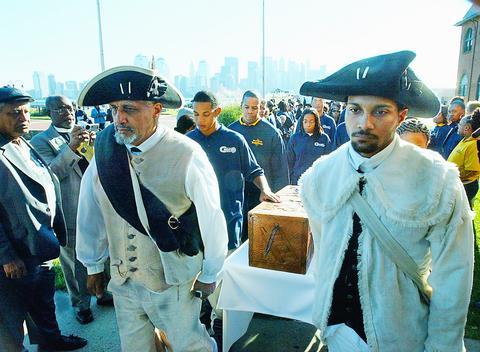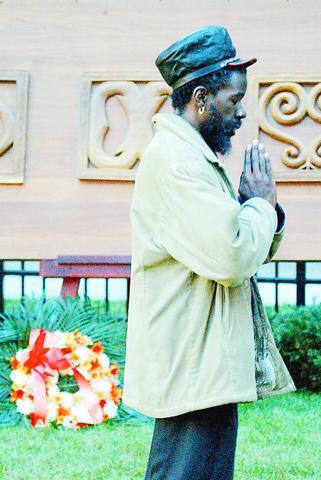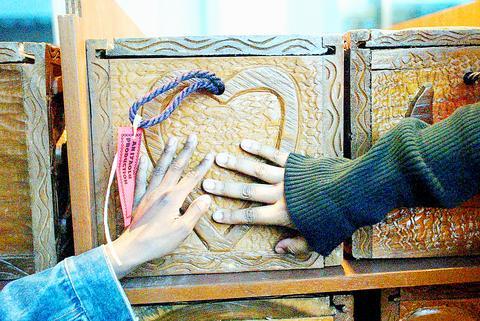The hole is dug. The crypts are ready to be filled. More than 400 hand-carved mahogany coffins, containing the skeletal remains of free and enslaved African-Americans, are sitting in a temperature-controlled room in Lower Manhattan.
After three centuries and 12 years, they are ready to be laid to rest for a second time.

PHOTO: NY TIMES
On Saturday, in a moment of joy and bitterness, the 18th-century remains were ceremonially lowered into the ground and covered, in the same place where they were discovered a dozen years ago as the federal government prepared to build an office tower. The reinterment followed a day and a half of observances, including a procession up the Canyon of Heroes in Lower Manhattan. It also brought a symbolic close to an especially tumultuous chapter in the city's racial history.

PHOTO: NY TIMES
The joy, those close to the project agree, comes from seeing the belated celebration of lives and history once forgotten. The bitterness, they say, stems from the fact they had to be reburied at all.
"It was the considered judgment of virtually every African-American I knew that they shouldn't have been disturbed in the first place," said Howard Dodson, director of the Schomburg Center for Research in Black Culture, which helped bring together all the factions seeking a voice in the project.

The discovery of the remains, in a huge Colonial-era cemetery, have offered anthropologists a rare glimpse into the lives of the first black Americans in New York, which in the 18th century had more slaves than any other city in the country besides Charleston, South Carolina. Some skeletons, for instance, were found with holes in the collar bones, a sign that the person was forced to carry loads as heavy as 40kg to 80kg.
But the find also touched off a battle that pitted the federal government's desire to complete a long-delayed building project against the sensitivities of African-Americans. Even after the government bowed to political pressure and agreed to preserve a small piece of the burial plot, the effort to rebury the remains bogged down in wrangling over the details.
It all began in 1991, when the General Services Administration (GSA) began preliminary work on a US$276 million, 34-story federal office tower at 290 Broadway. Early on, archaeologists working for the agency stumbled upon part of an 18th-century cemetery, once known as the Negros Burial Ground, that is believed to hold as many as 20,000 bodies.
Historians had believed that little remained of the burial ground, which covered what was then a desolate five-acre patch on the outskirts of New York. City maps showed that portions of the cemetery had been paved over as early as the late 18th century.
As it turned out, the remains had been protected by nearly 20 feet of landfill deposited on the site during the early 19th century. Workers first found rotting wooden coffins, then actual remains, virtually intact.
The GSA's initial plan was to simply exhume the bodies and continue construction, which had fallen badly behind schedule. But after an outcry from blacks and preservationists -- joined by Mayor David N. Dinkins and members of Congress -- the agency agreed to redraw the blueprints for the building. It eliminated plans for an underground parking garage and a four-story pavilion that was supposed to be built over the graves.
The agency agreed to preserve a portion of the area that was originally dug up and use a section of it to rebury the 419 sets of remains that had been uncovered. More than 200 remains were left untouched.
A federal steering committee was set up in late 1992 to help decide the future of the African Burial Ground, as it was now called. By then, the scientists involved realized they had a significant discovery on their hands.
But after many African-Americans argued that GSA archaeologists could not have the proper reverence for the remains, the federal committee ordered that they be turned over for study to a black team, led by Dr. Michael Blakey, at Howard University in Washington. Scientists there would also examine more than 1.5 million artifacts of everyday life, from pottery and glassware to tools and children's toys, that had been recovered at the site and a separate excavation nearby.
By decade's end, however more than US$20 million had been spent on the study and memorial project, with no progress made toward the main goal, a reburial. There were charges of foot-dragging and neglect.
"The problems just symbolize the problems for people of African descent in this country," said Ayo Harrington, who heads Friends of the African Burial Ground, a private group that has voiced frustration with the GSA.
In 2001, a new agency administrator made completing the project a priority.
Blakey's team has finished a draft of an 800-page report on their findings. Among their conclusions: About half of the remains were from children. They estimate that in the 1700s, when blacks made up as much as one-fifth of the city's population, more than half died at birth or in the first few years of life.
Scientists numbered the remains as they uncovered them. Burial No. 25 was a woman with a musket ball embedded in her rib cage. No. 340 was a woman in her late 40s wearing a girdle of glass beads, possibly from Africa. Nos. 335 and 356 were a mother and her infant child in her arms.
No. 101 was a man whose coffin bore markings from a Ghanian tribe. The symbol, called a sankofa, means roughly to "return to the past in order to build the future," a slogan that Wilson's office has adopted for the entire project.
The events that begin on Friday in New York actually culminated six days of festivities that began earlier in the week in Washington. Four sets of remains, those of a man, a woman, a boy and a girl, were sent this week on a tour through Washington, Baltimore, Wilmington, Delaware, Philadelphia, Newark, New Jersey, and finally New York.
On Friday morning, the four coffins arrived at South and Wall streets, the site of Colonial New York's slave market. They were then joined up with roughly a third of the remains on caissons and proceeded up Broadway to the burial ground.
On Wednesday at the burial site, workers applied the finishing touches to the crypts that the coffins will be placed in, and painted the derrick that will be used to lower them into the ground.
Among those in the entirely black work crew was Carl Williams. Williams' construction firm was helping archaeologists excavate the site 12 years ago when the remains were discovered. More than a decade later, his company was asked to return to handle the reburial.
Williams, 56, who is from Trinidad, said his crew had been hard at work for the last two weeks. He takes pride, he said, in having found a way to serve these people who carry so much significance.
Before the burial on Saturday, he said many people might still be angry that it had taken so long, but "I will be happy," he said. "And proud."

In Taiwan there are two economies: the shiny high tech export economy epitomized by Taiwan Semiconductor Manufacturing Co (TSMC, 台積電) and its outsized effect on global supply chains, and the domestic economy, driven by construction and powered by flows of gravel, sand and government contracts. The latter supports the former: we can have an economy without TSMC, but we can’t have one without construction. The labor shortage has heavily impacted public construction in Taiwan. For example, the first phase of the MRT Wanda Line in Taipei, originally slated for next year, has been pushed back to 2027. The government

July 22 to July 28 The Love River’s (愛河) four-decade run as the host of Kaohsiung’s annual dragon boat races came to an abrupt end in 1971 — the once pristine waterway had become too polluted. The 1970 event was infamous for the putrid stench permeating the air, exacerbated by contestants splashing water and sludge onto the shore and even the onlookers. The relocation of the festivities officially marked the “death” of the river, whose condition had rapidly deteriorated during the previous decade. The myriad factories upstream were only partly to blame; as Kaohsiung’s population boomed in the 1960s, all household

Allegations of corruption against three heavyweight politicians from the three major parties are big in the news now. On Wednesday, prosecutors indicted Hsinchu County Commissioner Yang Wen-ke (楊文科) of the Chinese Nationalist Party (KMT), a judgment is expected this week in the case involving Hsinchu Mayor Ann Kao (高虹安) of the Taiwan People’s Party (TPP) and former deputy premier and Taoyuan Mayor Cheng Wen-tsan (鄭文燦) of the Democratic Progressive Party (DPP) is being held incommunicado in prison. Unlike the other two cases, Cheng’s case has generated considerable speculation, rumors, suspicions and conspiracy theories from both the pan-blue and pan-green camps.

Stepping inside Waley Art (水谷藝術) in Taipei’s historic Wanhua District (萬華區) one leaves the motorcycle growl and air-conditioner purr of the street and enters a very different sonic realm. Speakers hiss, machines whir and objects chime from all five floors of the shophouse-turned- contemporary art gallery (including the basement). “It’s a bit of a metaphor, the stacking of gallery floors is like the layering of sounds,” observes Australian conceptual artist Samuel Beilby, whose audio installation HZ & Machinic Paragenesis occupies the ground floor of the gallery space. He’s not wrong. Put ‘em in a Box (我們把它都裝在一個盒子裡), which runs until Aug. 18, invites